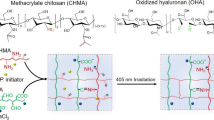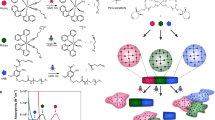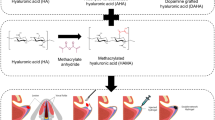Abstract
The design of injectable hydrogel systems addresses the growing demand for minimally invasive approaches for local and sustained delivery of therapeutics. We developed a class of hyaluronic acid (HA) hydrogels that form through noncovalent guest–host interactions, undergo disassembly (shear-thinning) when injected through a syringe and then reassemble within seconds (self-healing) when shear forces are removed. Its unique properties enable the use of this hydrogel system for numerous applications, such as injection in vivo (including with cells and therapeutic molecules) or as a 'bioink' in 3D-printing applications. Here, we describe the functionalization of HA either with adamantanes (guest moieties) via controlled esterification or with β-cyclodextrins (host moieties) through amidation. We also describe how to modify the HA derivatives with methacrylates for secondary covalent cross-linking and for reaction with fluorophores for in vitro and in vivo imaging. HA polymers are rationally designed from relatively low-molecular-weight starting materials, with the degree of modification controlled, and have matched guest-to-host stoichiometry, allowing the preparation of hydrogels with tailored properties. This procedure takes 3–4 weeks to complete. We detail the preparation and characterization of the guest–host hydrogels, including assessment of their rheological properties, erosion and biomolecule release in vitro. We furthermore demonstrate how to encapsulate cells in vitro and provide procedures for quantitative assessment of in vivo hydrogel degradation by imaging of fluorescently derivatized materials.
This is a preview of subscription content, access via your institution
Access options
Access Nature and 54 other Nature Portfolio journals
Get Nature+, our best-value online-access subscription
$29.99 / 30 days
cancel any time
Subscribe to this journal
Receive 12 print issues and online access
$259.00 per year
only $21.58 per issue
Buy this article
- Purchase on Springer Link
- Instant access to full article PDF
Prices may be subject to local taxes which are calculated during checkout







Similar content being viewed by others
References
Li, J. & Mooney, D.J. Designing hydrogels for controlled drug delivery. Nat. Rev. Mater. 1, 16071 (2016).
Burdick, J.A. & Murphy, W.L. Moving from static to dynamic complexity in hydrogel design. Nat. Commun. 3, 1269 (2012).
Drury, J.L. & Mooney, D.J. Hydrogels for tissue engineering: scaffold design variables and applications. Biomaterials 24, 4337–4351 (2003).
Ifkovits, J.L. & Burdick, J.A. Review: photopolymerizable and degradable biomaterials for tissue engineering applications. Tissue Eng. 13, 2369–2385 (2007).
Nguyen, K.T. & West, J.L. Photopolymerizable hydrogels for tissue engineering applications. Biomaterials 23, 4307–4314 (2002).
Ifkovits, J.L. et al. Injectable hydrogel properties influence infarct expansion and extent of postinfarction left ventricular remodeling in an ovine model. Proc. Natl. Acad. Sci. USA 107, 11507–11512 (2010).
Jin, R. et al. Synthesis and characterization of hyaluronic acid–poly(ethylene glycol) hydrogels via Michael addition: an injectable biomaterial for cartilage repair. Acta Biomater. 6, 1968–1977 (2010).
Lehn, J.-M. Perspectives in supramolecular chemistry—from molecular recognition towards molecular information processing and self-organization. Angew. Chem. Int. Ed. Engl. 29, 1304–1319 (1990).
Tibbitt, M.W., Rodell, C.B., Burdick, J.A. & Anseth, K.S. Progress in material design for biomedical applications. Proc. Natl. Acad. Sci. USA 112, 14444–14451 (2015).
Wang, H. & Heilshorn, S.C. Adaptable hydrogel networks with reversible linkages for tissue engineering. Adv. Mater. 27, 3717–3736 (2015).
Webber, M.J., Appel, E.A., Meijer, E.W. & Langer, R. Supramolecular biomaterials. Nat. Mater. 15, 13–26 (2016).
Guvendiren, M., Lu, H.D. & Burdick, J.A. Shear-thinning hydrogels for biomedical applications. Soft Matter 8, 260–272 (2012).
DiMarco, R.L. & Heilshorn, S.C. Multifunctional materials through modular protein engineering. Adv. Mater. 24, 3923–3940 (2012).
Lu, H.D., Charati, M.B., Kim, I.L. & Burdick, J.A. Injectable shear-thinning hydrogels engineered with a self-assembling Dock-and-Lock mechanism. Biomaterials 33, 2145–2153 (2012).
Rodell, C.B., Mealy, J.E. & Burdick, J.A. Supramolecular guest-host interactions for the preparation of biomedical materials. Bioconjug. Chem. 26, 2279–2289 (2015).
Yang, X. et al. Self-healing polymer materials constructed by macrocycle-based host-guest interactions. Soft Matter 11, 1242–1252 (2015).
Ma, X. & Zhao, Y. Biomedical applications of supramolecular systems based on host–guest interactions. Chem. Rev. 115, 7794–7839 (2015).
Highley, C.B., Prestwich, G.D. & Burdick, J.A. Recent advances in hyaluronic acid hydrogels for biomedical applications. Curr. Opin. Biotechnol. 40, 35–40 (2016).
Charlot, A. & Auzély-Velty, R. Synthesis of novel supramolecular assemblies based on hyaluronic acid derivatives bearing bivalent β-cyclodextrin and adamantane moieties. Macromolecules 40, 1147–1158 (2007).
Charlot, A., Auzély-Velty, R. & Rinaudo, M. Specific interactions in model charged polysaccharide systems. J. Phys. Chem. B 107, 8248–8254 (2003).
Semenov, A., Charlot, A., Auzély-Velty, R. & Rinaudo, M. Rheological properties of binary associating polymers. Rheol. Acta 46, 541–568 (2007).
Rodell, C.B., Kaminski, A.L. & Burdick, J.A. Rational design of network properties in guest-host assembled and shear-thinning hyaluronic acid hydrogels. Biomacromolecules 14, 4125–4134 (2013).
Gaffey, A.C. et al. Injectable shear-thinning hydrogels used to deliver endothelial progenitor cells, enhance cell engraftment, and improve ischemic myocardium. J. Thorac. Cardiovasc. Surg. 150, 1268–1276 (2015).
Rodell, C.B. et al. Shear-thinning supramolecular hydrogels with secondary autonomous covalent crosslinking to modulate viscoelastic properties in vivo. Adv. Funct. Mater. 25, 636–644 (2015).
Rodell, C.B. et al. Injectable shear-thinning hydrogels for minimally invasive delivery to infarcted myocardium to limit left ventricular remodeling. Circ. Cardiovasc. Interv. 9, e004058 (2016).
Rodell, C.B., Rai, R., Faubel, S., Burdick, J.A. & Soranno, D.E. Local immunotherapy via delivery of interleukin-10 and transforming growth factor β antagonist for treatment of chronic kidney disease. J. Control Release 206, 131–139 (2015).
Soranno, D.E. et al. Delivery of interleukin-10 via injectable hydrogels improves renal outcomes and reduces systemic inflammation following ischemic acute kidney injury in mice. Am. J. Physiol. Renal Physiol. 311, F362–F372 (2016).
Highley, C.B., Rodell, C.B. & Burdick, J.A. Direct 3D printing of shear-thinning hydrogels into self-healing hydrogels. Adv. Mater. 27, 5075–5079 (2015).
Ouyang, L., Highley, C.B., Rodell, C.B., Sun, W. & Burdick, J.A. 3D printing of shear-thinning hyaluronic acid hydrogels with secondary cross-linking. ACS Biomater. Sci. Eng. 2, 1743–1751 (2016).
Lu, H.D., Soranno, D.E., Rodell, C.B., Kim, I.L. & Burdick, J.A. Secondary photocrosslinking of injectable shear-thinning dock-and-lock hydrogels. Adv. Healthc. Mater. 2, 1028–1036 (2013).
Cai, L., Dewi, R.E. & Heilshorn, S.C. Injectable hydrogels with in situ double network formation enhance retention of transplanted stem cells. Adv. Funct. Mater. 25, 1344–1351 (2015).
van de Manakker, F., Kroon-Batenburg, L.M., Vermonden, T., van Nostrum, C.F. & Hennink, W.E. Supramolecular hydrogels formed by β-cyclodextrin self-association and host–guest inclusion complexes. Soft Matter 6, 187–194 (2010).
Wang, L.L. et al. Injectable, guest-host assembled polyethylenimine hydrogel for siRNA delivery. Biomacromolecules 18, 77–86 (2017).
Soranno, D.E., Lu, H.D., Weber, H.M., Rai, R. & Burdick, J.A. Immunotherapy with injectable hydrogels to treat obstructive nephropathy. J. Biomed. Mater. Res. A 102, 2173–2180 (2014).
Miyajima, A. et al. Antibody to transforming growth factor-beta ameliorates tubular apoptosis in unilateral ureteral obstruction. Kidney Int. 58, 2301–2313 (2000).
Mealy, J.E., Rodell, C.B. & Burdick, J.A. Sustained small molecule delivery from injectable hyaluronic acid hydrogels through host-guest mediated retention. J. Mater. Chem. B Mater. Biol. Med. 3, 8010–8019 (2015).
Roche, E.T. et al. Comparison of biomaterial delivery vehicles for improving acute retention of stem cells in the infarcted heart. Biomaterials 35, 6850–6858 (2014).
Burdick, J.A., Mauck, R.L. & Gerecht, S. To serve and protect: hydrogels to improve stem cell-based therapies. Cell Stem Cell 18, 13–15 (2016).
Caliari, S.R. et al. Stiffening hydrogels for investigating the dynamics of hepatic stellate cell mechanotransduction during myofibroblast activation. Sci. Rep. 6, 21387 (2016).
Rodell, C.B., Dusaj, N.N., Highley, C.B. & Burdick, J.A. Injectable and cytocompatible tough double-network hydrogels through tandem supramolecular and covalent crosslinking. Adv. Mater. 28, 8419–8424 (2016).
Boekhoven, J., RubertPérez, C.M., Sur, S., Worthy, A. & Stupp, S.I. Dynamic display of bioactivity through host–guest chemistry. Angew. Chem. Int. Ed. Engl. 52, 12077–12080 (2013).
Li, H., Frith, J. & Cooper-White, J.J. Modulation of stem cell adhesion and morphology via facile control over surface presentation of cell adhesion molecules. Biomacromolecules 15, 43–52 (2014).
Rodell, C.B., Wade, R.J., Purcell, B.P., Dusaj, N.N. & Burdick, J.A. Selective proteolytic degradation of guest–host assembled, injectable hyaluronic acid hydrogels. ACS Biomater. Sci. Eng. 1, 277–286 (2015).
Burdick, J.A., Chung, C., Jia, X., Randolph, M.A. & Langer, R. Controlled degradation and mechanical behavior of photopolymerized hyaluronic acid networks. Biomacromolecules 6, 386–391 (2005).
Smeds, K.A. & Grinstaff, M.W. Photocrosslinkable polysaccharides for in situ hydrogel formation. J. Biomed. Mater. Res. A 54, 115–121 (2001).
Sahoo, S., Chung, C., Khetan, S. & Burdick, J.A. Hydrolytically degradable hyaluronic acid hydrogels with controlled temporal structures. Biomacromolecules 9, 1088–1092 (2008).
McNaughton, M., Engman, L., Birmingham, A., Powis, G. & Cotgreave, I.A. Cyclodextrin-derived diorganyl tellurides as glutathione peroxidase mimics and inhibitors of thioredoxin reductase and cancer cell growth. J. Med. Chem. 47, 233–239 (2004).
Kaya, E. & Mathias, L.J. Synthesis and characterization of physical crosslinking systems based on cyclodextrin inclusion/host-guest complexation. J. Polym. Sci. A Polym. Chem. 48, 581–592 (2010).
Coin, I., Beyermann, M. & Bienert, M. Solid-phase peptide synthesis: from standard procedures to the synthesis of difficult sequences. Nat. Protoc. 2, 3247–3256 (2007).
Acknowledgements
The authors are grateful for financial support from the National Science Foundation (DMR Award 1610525), an NIH/NIAMS training grant (T32-AR007132; M.H.C.), a postdoctoral fellowship (C.L.) from the IBSA Foundation, Switzerland, and predoctoral fellowships (C.B.R., M.H.C.) and an Established Investigator Award (J.A.B) from the American Heart Association.
Author information
Authors and Affiliations
Contributions
C.L., C.B.R. and M.H.C. performed the experiments and analyzed data. All authors wrote the manuscript, and J.A.B. supervised the research.
Corresponding author
Ethics declarations
Competing interests
The authors declare no competing financial interests.
Integrated supplementary information
Supplementary Figure 1 Rheological characterization of a representative CD-MeHA and Ad-MeHA hydrogel before and after covalent crosslinking (20% modified CD-MeHA mixed with 20% modified Ad-MeHA, stoichiometric ratio 1:1, 3.5% (wt/vol) polymer concentration).
(a) Frequency dependence of GH hydrogels presents an increasing storage modulus (G’) at higher frequencies. (b) Photocrosslinking in the presence of UV light and a radical photoinitiator (0.05% Irgacure 2959) induced mechanical stabilization of the material as shown by an increased G’ and reduced frequency dependence with a lack of re-arrangement (i.e. no cross-over of the G’ and G’’).
Supplementary Figure 2 Preparation of agarose well-in-well molds for culturing cellular guest-host hydrogels.
(a) Customized plastic mold made of Acrylonitrile-Butadiene-Styrene (ABS). (b) The mold is designed to fit into a 24-well plate with inserts of 8 mm length and 5 mm diameter. (c) After solidification of 2 mL agarose, molds can be used to contain injected guest-host hydrogels for culture.
Supplementary Figure 3 Reaction setup for synthesis of 6-o-monotosyl-6-deoxy-β-cyclodextrin (CD-Tos) and 6-(6-aminohexyl)amino-6-deoxy-β-cyclodextrin (CD-HDA).
Setup for (a) CD-Tos and (b) CD-HDA synthesis under anhydrous conditions.
Supplementary Figure 4 Rheological characterization of GH hydrogel replicates (20% modified CD-HA mixed with 20% modified Ad-HA, stoichiometric ratio 1:1, 7.5% (wt/vol) polymer concentration).
Frequency sweeps with G’ (filled symbols) and G’’ (open symbols) show the crossover of G’ and G’’ and the reproducibility of the measurement (n=3).
Supplementary Figure 5 Erosion and molecule release characteristics of GH hydrogels.
Examples for (a) cumulative hydrogel erosion profile and (b) FITC-BSA (0.1% (wt/vol)) release for 5% (wt/vol) GH hydrogels over 60 days (n=3, mean ± SD).
Supplementary Figure 6 In vivo fluorescence imaging of GH hydrogels pre- and post injection subcutaneously in the right flank of mice.
Representative overlay of near-infrared and black and white images taken after subcutaneous injection of 25 μl GH hydrogels (3.5% (wt/vol) and subsequently over 14 days illustrate degradation behavior in vivo (Pearl® Impulse, LI-COR, λex/λem = 785/820 nm).
Supplementary Figure 7 Confocal microscopy (calcein and ethidium staining) of encapsulated human MSCs.
Human MSCs (5x106/mL) were encapsulated in GH hydrogels (5% (wt/vol)) and high viability (95%) was observed after 24 h, scale bar 200 μm.
Supplementary Figure 8 1H NMR spectrum of methacrylated hyaluronic acid in D2O.
Methacrylate modification (26% shown) is determined by integration of the vinyl singlets (1H each, shaded green) relative to the sugar ring of hyaluronic acid (HA, 10H, shaded gray).
Supplementary Figure 9 1H NMR spectra of tetrabutyl ammonium salt of hyaluronic acid (HA-TBA) and methacrylated hyaluronic acid (MeHA-TBA) in D2O.
Modification of (a) HA with TBA salt is determined by the integration of the TBA methyl-groups (12H, shaded brown) relative to the N-acetyl group of HA (3H, shaded gray). Modification of (b) methacrylation and TBA salt is determined by the integration of the TBA methyl-groups (3H, shaded brown) and the vinyl singlets (1H each, shaded green) relative to the sugar ring of hyaluronic acid (HA, 10H, shaded gray).
Supplementary Figure 10 1H NMR spectrum of 6-o-monotosyl-6-deoxy-β-cyclodextrin (CD-Tos) in DMSO-d6.
Tosylation of CD is confirmed by integration of the methyl (3H, shaded red) and aromatic hydrogens (2H each, shaded orange), relative to the secondary hydroxyls of CD (14H, shaded gray). Anticipated minor impurities in the spectra may include trace acetone (δ = 2.10), ammonium chloride (δ = 6.98, 7.12, 2.27 (s)), ethyl ether (δ = 3.42 (q), 1.13 (t, 3H)), and water (see Supplementary Figure 11).
Supplementary Figure 11 1H NMR spectrum of 6-o-monotosyl-6-deoxy-β-cyclodextrin (CD-Tos) in DMSO-d6.
The product was not fully dried, which causes combination of the HOD peak with the hydroxyl groups of the CD ring (purple shaded), prohibiting reliable integration of the CD necessary to confirm mono-tosylation.
Supplementary Figure 12 1H NMR spectrum of 6-(6-aminohexyl)amino-6-deoxy-β-cyclodextrin (CD-HDA) in DMSO-d6.
Modification of CD with HDA is determined by integration of the hexane linker (12H, shaded red) relative to the secondary hydroxyls of CD (14H, shaded gray). Anticipated minor impurities in the spectra may include trace dimethlyformamide (δ = 7.98, 2.92, 2.08), acetone (δ = 2.10), and ethyl ether (δ = 3.42 (q), 1.13 (t, 3H)).
Supplementary Figure 13 1H NMR spectra of β-cyclodextrin modification of hyaluronic acid (CD-HA) and methacrylated hyaluronic acid (MeHA-CD) in D2O.
(a) Modification of HA with pendant CD (30.2%) is determined by integration of the hexane linkers (12H, shaded red) relative to the N-acetyl singlet of HA (3H, shaded gray). (b) CD functionalization of MeHA shows an overlap of the spectra of the modifications with the sugar ring and the N-acetyl group of HA. Therefore, to determine the modification of MeHA with CD (30.3%), the hexane linker (12H, shaded red) is integrated relative to the methacrylate modification, which is assumed to be conserved throughout the reaction (25%, 1H each, shaded green).
Supplementary Figure 14 1H NMR spectra of adamantane functionalization of hyaluronic acid (Ad-HA) and methacrylated adamantane hyaluronic acid (Ad-MeHA) in D2O.
(a) Modification of HA with pendant Ad (32.5%) is determined by integration of the ethyl multiplet (12H, shaded blue) relative to the sugar ring of HA (10H, shaded gray). (b) Modification of MeHA with pendant Ad (32.8%) is determined by integration of the ethyl multiplet (12H, shaded blue) relative to the sugar ring of HA (10H, shaded gray). Integration of the vinyl singlets (1H each, shaded green) relative to the sugar ring of hyaluronic acid (HA, 10H, shaded gray) confirms the conservation of the methacrylate modification.
Supplementary Figure 15 Confocal microscopy (calcein and ethidium staining) of rat endothelial progenitor cells (EPCs) encapsulated in GH hydrogels (5% (wt/vol)).
EPCs were not homogenously mixed with the GH hydrogel, which caused poor cell viability (45.5%) after injection through a 25G ¼ needle, scale bar 200 μm.
Supplementary information
Supplementary Text and Figures
Supplementary Figures 1–15. (PDF 1700 kb)
Supplementary Data (zip file).
Stereolithography file for plastic mold. (ZIP 118 kb)
Supplementary Video 1.
Mixing of CD-HA and Ad-HA in a tube. (MP4 2536 kb)
Supplementary Video 2.
Loading of a syringe with preformed GH hydrogels and subsequent injection. (MP4 3289 kb)
Supplementary Video 3.
Injection of GH hydrogels into customized acrylamide molds. (MP4 2381 kb)
Supplementary Video 4.
Mixing of CD-HA and Ad-HA in the back of a syringe. (MP4 2002 kb)
Rights and permissions
About this article
Cite this article
Loebel, C., Rodell, C., Chen, M. et al. Shear-thinning and self-healing hydrogels as injectable therapeutics and for 3D-printing. Nat Protoc 12, 1521–1541 (2017). https://doi.org/10.1038/nprot.2017.053
Published:
Issue Date:
DOI: https://doi.org/10.1038/nprot.2017.053
This article is cited by
-
Microinterfaces in biopolymer-based bicontinuous hydrogels guide rapid 3D cell migration
Nature Communications (2024)
-
Clinical translation of wireless soft robotic medical devices
Nature Reviews Bioengineering (2024)
-
3D bioprinting of microorganisms: principles and applications
Bioprocess and Biosystems Engineering (2024)
-
Polyelectrolyte complexes based on a novel and sustainable hemicellulose-rich lignosulphonate for drug delivery applications
Drug Delivery and Translational Research (2024)
-
3D printed scaffolds based on hyaluronic acid bioinks for tissue engineering: a review
Biomaterials Research (2023)
Comments
By submitting a comment you agree to abide by our Terms and Community Guidelines. If you find something abusive or that does not comply with our terms or guidelines please flag it as inappropriate.



